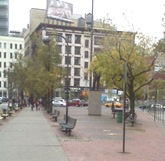Rescuing Street Trees to Improve the City’s Climate
New York City currently has some 14,000,000 trees, some 550,000 of them growing along our streets, all 14 million of them working for us full-time. The city’s trees capture tons of carbon dioxide and other pollutants, they save energy by lowering air temperatures in summer and slowing wind speeds in winter. They capture rain water that would otherwise overload the city’s drains and send sewage flowing into its rivers. Their presence on any street makes people feel better and raises property values. They do this 24/7 and never complain.
You might file these facts under the “Isn’t that nice?” category because this information might seem unimportant compared to important things like, “Where can I get a good cup of coffee?” But trees matter in New York – and, the rest of the world because at this very minute, millions of people are moving from the countryside into cities.
By 2050, 70 per cent of the eight billion people then on earth will live in urban areas. If these places don’t become more ecologically viable than they are right now, most of humanity will be very sick and very angry – or at the least, sicker and angrier than at this moment. Clearly, having a lot of trees in a city is a major component of a viable urban future, and that’s what New York and many other cities are working on.
By 2017, a million more trees will be added to New York’s streets, parks and gardens through Mayor Bloomberg’s “MillionTreesNYC” program. Planting the new trees this ambitious project requires has been taken on by the New York Restoration Project, an organization founded by the performer Bette Midler. The job is ahead of schedule. Midler and the Mayor planted the 250,000th tree on October 1st.
But if trees are to make a better environment for urban people, urban people must also create a viable environment for trees. That’s why fifteen people showed up in Duarte Park in downtown Manhattan on a cool October noon to practice what they’d learned in a two-hour “Tree Stewardship Workshop” sponsored by the City to rustle up more volunteers to care for its street trees. Except for its dozen-odd struggling plane trees, Duarte Park is a barren brick-paved triangle at the traffic-heavy start of Avenue of the Americas.
The group came to understand why the trees were having such a hard time: everything they had just learned not to do, had been done to these trees. Our instructors, Jamie Daugherty and Art Simpson, both foresters for the New York City Parks Department, started off by giving us a lot of background. Like most city street trees, Duarte Park’s elms had been planted in a five-by-five-foot “tree coffin.” Unlikely to have enough room to spread their roots, blasted by hot car exhausts and air conditioners, the earth around their roots compacted and polluted by peeing dogs and spilled coffee, street trees are orphans from day one. The “coffin” around each Duarte Park tree had also been wholly or partly filled with gray paving stones; what dirt remained was packed in as hard as cement. It was a miracle that any rainwater reached the roots. The group could hardly wait to liberate them.
The people attending the workshop were probably typical of the persons who becomes a New York “tree steward.” All 15 had some kind of involvement with trees on their local streets. Retired computer scientist David Reich heads up his Upper West Side block association, which has an active tree care effort. A Queens couple had come to learn about ways to tend the trees that had recently been planted in front of their children’s school. Jaqueline Finney, an artist, wanted to find out how to get branches to use in her work. (Much to her disappointment, the foresters told her that she was out of luck. All prunings must be bagged and turned over to the city, which chops them into mulch. Nothing could be kept for art.)
When the workshop ended, the group headed for Duarte Park. Each member had been given a five-gallon bucket, a hand rake, a prying tool and a pair of work gloves. They pried out paving stones as if they were freeing trapped survivors. they loosened as much of the compacted soil as their hand rakes could reach. Finally, they watered their rescued trees from the water from a nearby fire hydrant. The foresters carted away most of the stones in a van whose shocks, it was hoped, would survive the trip to Queens. Now it was up to the individual members of the workshop to take their tools and buckets and adopt a tree in their own neighborhood for the long run.



